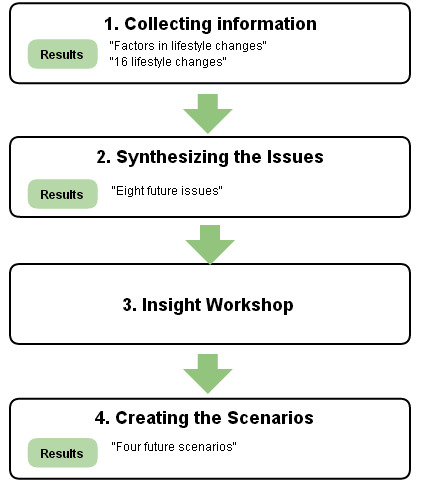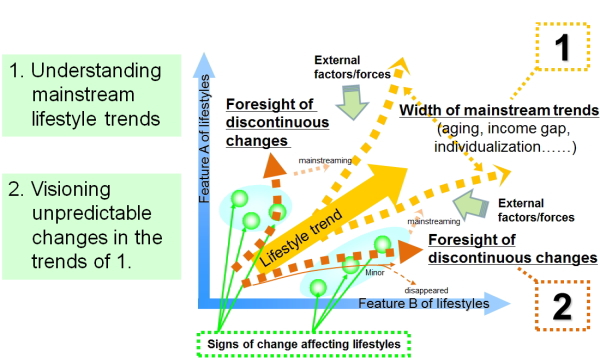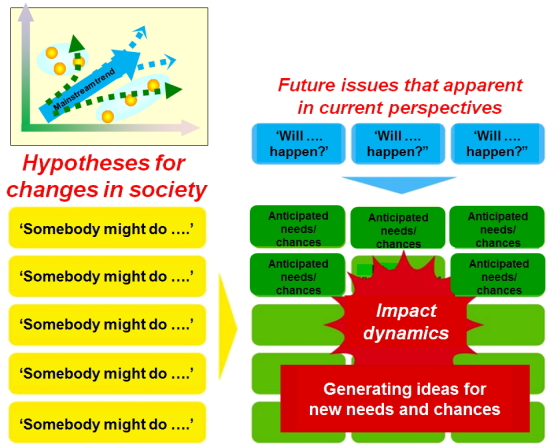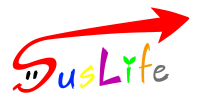The Background of the Research
Recent years have seen increasing diversity in our lifestyles and consumption patterns, because of social changes such as the aging population and globalization, and changes in attitudes and norms such as the advance of women in society and greater numbers of people marrying later or not at all. Here at NIES, we have previously used the scenario approach for research into future scenarios (for example, in the "Japan Low Carbon Society 2050" and "Near-Future Material Cycle Society Scenarios" ) but we have not given much consideration to the diversity and complexity of individual lifestyles and consumption patterns.
When we look at the real world, we see that single person households have increased relative to the nuclear family households that were previously taken to be the standard household, and that individualization has been aided by the spread of computer technology. Changes in the environments that individuals and families live in are having new effects on modes of working and transport. For example, as home-working and cloud-sourcing increase and more people are making the choice to work at home or freelance, there is less need for people to travel from homes in the suburbs to central urban areas for work.
What do we mean by Sustainable Lifestyles and Consumption?
"Sustainable lifestyles means patterns of behavior and consumption that provide a better quality of life than just meeting the basic needs of individuals; minimize the use of natural resources and discharges of waste and toxic materials through product life cycles; and do not endanger the ability of future generations to meet their own needs. People use these patterns to create and identify fellowship with others or to differentiate themselves with others. Sustainable lifestyles must reflect the diversity of culture, nature, economics, and social heritage in a society.
Sustainable consumption is concerned with processes of purchasing, consuming and disposing of goods and services, whereas sustainable lifestyles includes a slightly wider set of activities, for example, communication, leisure, sports and education ."
Reference: Report.PDF: Marrakech Task Force on Sustainable Lifestyles
UNEP Marrakech Process on SCP (Sustainable Consumption and Production) website: http://www.unep.fr/scp/marrakech/taskforces/lifestyles.htm
Research Methodology

First, using published documents and previous research, we identified causes of lifestyle changes and mainstream trends in lifestyle changes that will become major (mainstream) in the future. Then, working from "16 lifestyle changes", we identified which questions should be investigated when considering visions of the future in 2030. Using the future insight method developed by Hakuhodo, we specified potential future issues and devised ideas for future lifestyle scenarios that take account of unexpected changes in the future. From a range of perspectives, from the ideas that came up in our workshop, we considered how to portray diverse lifestyles and whether they were logical; then we specified details of the scenarios to create "future scenarios".
The Future insight Method
The basic structure of Hakuhodo Inc.'s insight method, based on Future Dynamics© is as follows: identifying intersections between mainstream trends for citizens, which are referred to as future issues, and insight of discontinuous lifestyle changes found by future scanning; discussing the intersections (conditional idea generation) in a workshop format; and creating future scenarios. With this method, insight of the future that are not "expected futures" or "desirable futures" but objectively devised "possible futures" can be portrayed.


Reference: Hakuhodo Innovation lab.
- About the Project
- Member
- Main results
- Publications
- Links
